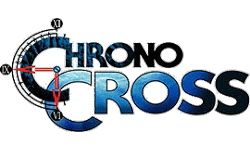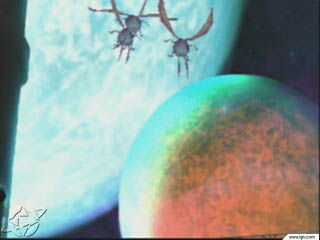|
|

|
PLATFORM
|
PSX
|
BATTLE SYSTEM
|

|
INTERACTION
|

|
ORIGINALITY
|

|
STORY
|

|
MUSIC & SOUND
|

|
VISUALS
|

|
CHALLENGE
|
Unbalanced
|
COMPLETION TIME
|
20-40 Hours
|
|
OVERALL

|
+ Escape option *always* works.
+ Decent music.
+ Great graphics.
- Combat is often unbalanced.
- Frequently lousy direction on how to advance.
- Sluggish, convoluted story.
|
Click here for scoring definitions
|
|
|
Serge, a resident of the tropical archipelago El Nido, one day stumbles upon a parallel world in which he died as a child, also encountering Kid, leader of a group of thieves known as the Radical Dreamers, and joining her to combat Lynx, uncover his mysterious past, and find the Frozen Flame. Square's Chrono Cross, the sequel to Chrono Trigger, is loosely based on a Japan-only game known as Radical Dreamers, something of a side story to Trigger, and saw its North American release in 2000. The sequel features dozens of gameplay changes from its highly-acclaimed predecessor, and itself received plenty of veneration upon crossing the Pacific. Does Chrono Cross live up to the hype?
As in Chrono Trigger, enemies are visible wandering the game's dungeons, with combat beginning when the player's party contacts them. Battles take place with the player's party of three characters squaring off against various enemies. Magical elements play a significant role in combat, with all characters and enemies having affiliations with one of six elements: red and blue, green and yellow, and black and white all respectively oppose one another. Each character has seven stamina points, with normal attacks coming in three flavors: weak, medium, and strong, with each respectively consuming one, two, and three stamina points.
Each character, moreover, can equip various levels of Elements in their Element grids, sort of a hybrid of consumable items and magic, the latter having one-time use in combat, although the former can stack up to five in Element slots. Elements become available for use in battle as characters attack the enemy, with weak, medium, and strong attacks respectively building up one, two, and three Element levels. Each type of normal attack has a certain degree of accuracy, with the player needing to use weaker attacks first to increase the hit rate of more powerful attacks, although these values repeatedly reset as a battle progresses.
Using Elements costs seven stamina points (and reduces available Element levels by the used Element's level), with a character's stamina able to fall below zero, in which case he/she cannot perform any actions until he/she has at least one stamina point. Enemies, of course, will naturally take their turns during combat, but it might have been nice were there a way to tell when enemy turns were impending, since they can annoyingly interrupt the player's chains of attack. Another aspect to consider is a gauge showing the colors of the three most recent Elements used; when all are the same color, the power of Elements of that color increases for both the player and the enemy, with the power of Elements of the opposing color conversely decreasing.
 Serge listens to Styx
Serge listens to Styx
|
|
Battles end, of course, when the player has obliterated the enemy; Chrono Cross's system of stat advancement, by the way, is vastly different from its predecessor's. Alongside money, occasional materials used for assembling weapons, armor, and accessories, and maybe some new Elements, some of each character's stats may increase, although stat advancement is capped based on how many special stars the player has acquired from killing bosses, and thus, the player cannot simply "level up" to get past tough bosses if necessary. Those stars gained from bosses also double to allow characters to cast powerful summon spells when the field color is of the Element of one of such spells the player wishes to cast.
Combat has some nice ideas, albeit somewhat flawed execution. For one, most normal battles with multiple foes tend to drag out, with a little lag in combat, as well. Mercifully, however, the escape option always works, even against bosses, but in some instances, boss fights will just instantly restart. Many, moreover, have for some reason underplayed the game's difficulty, with some bosses, especially late in the game, made harder by the rarity of revival Elements (this reviewer found a grand total of two) and cap on stat-building, and in many instances, trying to exploit their elemental weaknesses with allies of opposing elements is risky since bosses can easily slaughter them with their own skills. There are also supposedly double and triple techs, but frankly, there's a greater chance of being struck by lightning than finding these without a guide. All in all, combat is fun at first, but somewhat loses its appeal as the game drags on.
The interface isn't any better, although there are some strong points such as the ability to manage characters not in the player's party, alongside the ability to auto-allocate Elements to each character, which is handy considering that individually filling each Element slot for each character can be an absolute nightmare. Still, there are some annoyances such as the poor placement of save points at times (developers, always put them right before bosses), and the often-terrible direction on how to advance the main storyline, which will drive some players to use a guide (there are plenty of missable sidequests and items, as well). All in all, interaction isn't bad, although it could have been far better, as well.
Both the gameplay and story of Chrono Cross mainly set it apart from other RPGs, even if both filch some elements from other RPGs, the former borrowing a little from Xenogears (three levels of attack) and the latter being somewhat based on Radical Dreamers, although the overall product is still plentifully distinct even today.
 Giant bugs--the number one cause of planetary crashes
Giant bugs--the number one cause of planetary crashes
|
|
The story, unfortunately, is inarguably the game's low point. The idea of two dimensions is a nice one albeit terribly executed, with the links to Chrono Trigger being vague at best, alongside a number of anachronisms, holes, and many cryptic scenes and dialogues that create far more questions than solve. The pacing of the plot is also somewhat poor, with a huge gap in storytelling in the middle of the game, and most of the twists coming near the end. Furthermore, the sequel attempts to put together a large cast of playable characters a la the Suikoden titles, although few receive any real development, and their fates, unlike in the Suikoden games, are left to guess after the game's events. Even the "good" ending (which may require some to use a guide to ever see) creates plenty of questions, and ultimately, while the story has some nice ideas, it often screams as though its writers mostly developed it after a night of binge drinking gone horribly wrong.
One thing mostly done right, however, is the music, with Yasunori Mitsuda largely providing a decent soundtrack that features a few remixes from Chrono Trigger, with one of the overworld themes, for instance, being a tropical remix of the prequel's main theme. Many of the original tracks are nice, as well, and mostly fit the game's tropical milieu, although there are a few hiccups, with the normal battle theme, for one, sounding a bit corny after a while, and some areas relying on ambient noise, as seems to be the case with many games featuring Mitsuda as composer. Still, the game is fairly easy on the ears.
Easy on the eyes Chrono Cross is, as well, with nice pre-rendered environs conveying the game's tropical disposition alongside anatomically-correct character models and reasonably-fluid battle animation, even if the models and battles show some degree of shakiness and pixelation. Superb FMVs round out these visuals, which ultimately are another of the game's high points.
Finally, the game is about thirty hours long, with a New Game+ feature allowing for subsequent playthroughs. Overall, Chrono Cross is something of a letdown, both as a sequel to Chrono Trigger and an independent RPG. Things like an unbalanced combat system, frequent lack of direction on how to advance, and a sluggish, convoluted story damper its quality, although it's certainly not without redeeming aspects like its music and visuals. Ironic it is, as well, that despite the glowing ovation and decent sales it achieved, Square put the Chrono series on the backburner, allowing it to slumber through the following console generation.
Review Archives
|









